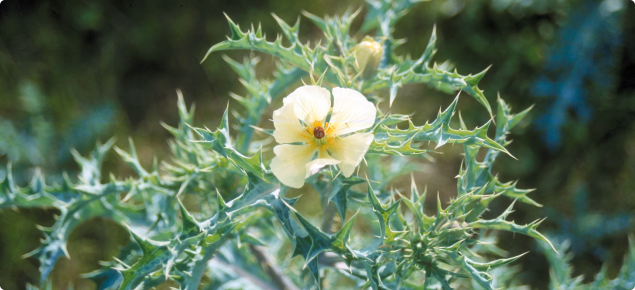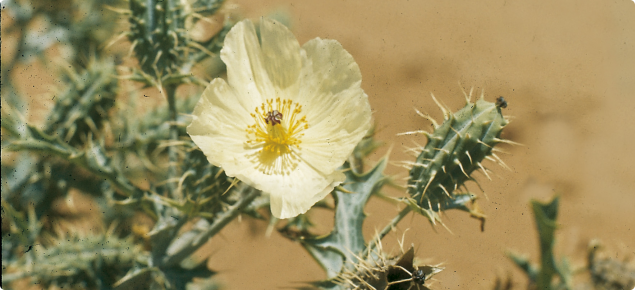What you should know about Mexican poppy
Mexican poppy (Argemone ochroleuca) is a member of the poppy family Papaveraceae and is native to Texas, Mexico and central America. Mexican poppy is widely established as a weed in the tropics. It has been introduced to Queensland and New South Wales and has become a troublesome weed in parts of Western Australia.
It is a weed in Western Australia. Control methods can be found through the Mexican poppy control link. In Western Australia it is widely distributed in the pastoral areas, mainly along river systems, on moist flats and in sand dunes. It is also present in some agricultural areas, but does not compete well with crops or properly managed pastures. Another closely related species of Mexican poppy (Argemone mexicana) is found elsewhere in Australia.
Why Mexican poppy matters to you
Mexican poppy is poisonous to stock, but few deaths occur because the plant is not readily eaten. This is due to the bitter yellow sap which makes it unpalatable to stock. Some stock have died after eating contaminated hay or chaff, and poultry have died after eating seeds. Mexican poppy seeds could be harvested with a wheat crop, thus contaminating the grain. However, the seeds are much smaller than wheat grains and can easily be removed by seed cleaning. Mexican poppy-infested grain is unsuitable for milling or stock feed.
What to look for
Mexican poppy grows up to one metre in height. It has typical poppy flowers, hollow stems and a ‘pepper shaker’ seed capsule. Prior to flowering it resembles a thistle because of its toothed and prickly leaves.
The plant is bluish-green or greyish-green in colour with waxy marbling to the leaves. The leaves, which grow up to 20 centimetres long, are silvery green with white veining and deep regular lobes. The upper surface of the leaf is smooth while the underside has a few prickles along the midribs. The stem leaves (in contrast to the rosette leaves) are stalkless and clasp onto the plant’s stem. The stems are cylindrical, whitish in colour and have scattered prickles. When broken, the stems exude a yellowish milky sap.
The flowers are about 6cm across. They have four light yellow or cream petals surrounding a dark red, three or six-lobed stigma. After fertilisation, a prickly oblong seed capsule develops. This is up to 3.5 centimetres in length with three to six openings at the top. Each capsule contains up to 400 seeds which are round, blackish brown, and about one millimetre in diameter with a pitted seed coat and a ridge along one side.
Suspect seeds can be submitted to the DDLS - Seed testing and certification services for identification. There is a fee for this service.
A. mexicana differs from A. ochroleuca in having a greener appearance and bright yellow flowers.
Life cycle
Mexican poppy is an annual plant. In the southwest of Western Australia it usually germinates in autumn and flowers from October to November. In other parts of the State its life cycle depends mainly on the availability of moisture.
Mexican poppy reproduces only from seed. The seed can stay dormant for many years, making control difficult. Seeds are carried by stock, farm implements, vehicles, water and in wool, hay, chaff and grain. Its occasional use as a garden plant may also contribute to its spread.
What you can do about Mexican poppy
Prompt action is required to eradicate isolated patches of Mexican poppy to prevent the weed establishing in new areas of Western Australia.
Practise good biosecurity to avoid introducing Mexican poppy or other weeds to your property and to avoid poisoning livestock.
Do not allow contractors with dirty machinery to work on your property – if necessary provide a washdown area so they can clean their equipment.
Report
| MyPestGuide™ Reporter | Pest and Disease Information Service (PaDIS) |
Control methods for this plant can be found through the APVMA website, use "mexican poppy" as the pest name.
Further information
Hussey, B.M.J., Keighery, G.J., Dodd, J., Lloyd, S.G.and Cousens, R.D. (2007) Western Weeds – a guide to the weeds of Western Australia, Second Edition. Weeds Society, Perth.
Parsons, W.T. and Cuthbertson, E.G. (2000) Noxious Weeds of Australia. CSIRO Publishing.


